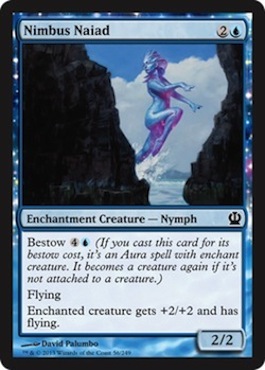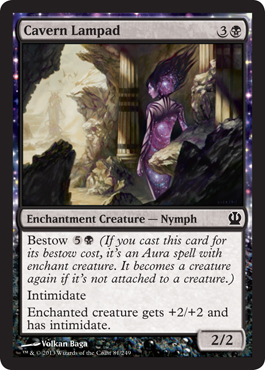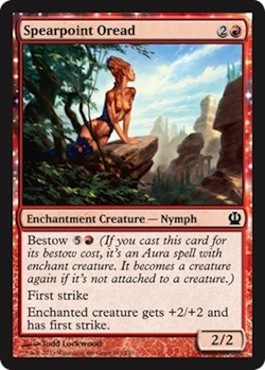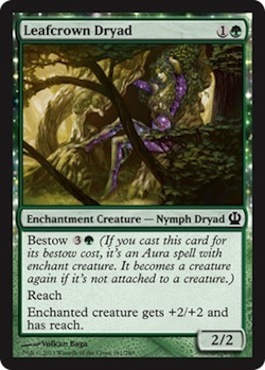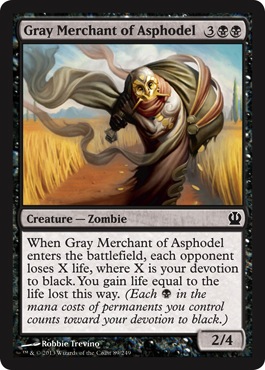Spoiler season is here again! But, as is typical, the Limited mages among us have to wait a bit longer than our 60-card brethren to see what we’ll be slinging this fall during sealed PTQ season. As of this writing (Wednesday night), 69 non-land cards have been spoiled, just 19 of which are commons (out of 101 total commons in Theros) and 15 uncommons (out of 80).
That’s 18% of both the commons and uncommons. Compare that to 24 of the rares (out of 53, or 45%) and 10 of the mythics (out of 15, or 67%). (There’s one more card that’s been spoiled, a sphinx called Medomai the Ageless, and he’s probably mythic, too, given that he gives you extra turns when he deals combat damage.)
The bad news? It takes us a while longer to see how the set will shape up for Limited Magic. The good news? We have so many more cards to see! Whereas those rare-mad brewers have basically already opened all of their Christmas presents.
We do have a number of cards to evaluate, though—perhaps most notably the enchantment creature cycle unveiled this week via Marshall Sutcliffe’s Limited Information column on the Mothership. Here they are:

First of all, how much does Matt “Counterspells Are Cool Now” Jones love that card frame? I love it, too, and can’t wait to see what it looks like IRL.
These five cards are the common marquee cards for both enchantment creatures and the bestow mechanic, which basically “fixes” the long-standing problem with aura enchantments: Namely, if you cast an aura enchantment on a creature, and your opponent removes that creature in response, then you are out a massive two cards. (And even if your opp. removes the creature later, you’re still out two cards, just not immediately.)
Traditionally, for that reason, auras haven’t been worth the risk, and most Limited thinkers have advised aura-happy newer players to chill out on the build-your-own-monster gimmick, and stick with creatures and spells. But over the past few years Wizards has been trying to rehabilitate the much-maligned aura. (Their first pass at a fixed aura was equipment, but this still fundamentally feels like an artifact, not an enchantment, and so I’m glad they’ve continued to go back to the drawing board on auras. There aren’t a super-large number of card types in Magic, and it would be a shame if one of them were ever to be consigned to the dustbin of history.)
Then, even more recently, Wizards started printing stupidly powerful aura spells, where the risk of getting two-for-one’d still remained—but the spell was so powerful that, if it stuck, it was (more) worth it. The best example of this (not counting Rancor, which kind of breaks the rules) is probably Knightly Valor, from Return to Ravnica, which many people initially dismissed as just another open-yourself-up-to-removal boner—and then, as the format developed, revealed itself as an exception powerful card. Vigilance and +2/+2 is big game—and the 2/2 vigilance knight token it left behind meant that, so long as you were careful about when you cast your aura spell (i.e., when your opponent was mostly tapped out, or out of removal), you weren’t going to get entirely two-for-one’d if the enchanted creature later bit the dust.
At this point it’s worth talking a bit about this particular cycle, and the white card in particular.
For 2W, you get a 2/2 vigilant nymph. That’s not exciting, but it’s fine. But here’s where bestow comes in: If you cast the card for its bestow cost, of 4W, it comes into play as an aura with enchant creature—meaning you choose a target creature, and it comes into play attached to that creature, same as a regular aura.
But here’s the rub: If your opponent responds by killing that target creature, bestow sort of makes the card slide off and just be a regular old 2/2 vigilant nymph. Sure, now you’ve paid 4W for a 2/2, which is terrible, but you didn’t get two-for-one’d either. And as we all know from playing with Knightly Valor, adding +2/+2 and vigilance to, say, a flying creature can make for a really hard-hitting attacker and blocker.
So is Observant Alseid as good as Knightly Valor? Sometimes. You don’t get the 2/2 knight that comes with K.V.—but you will if the enchanted creature ever dies. And, unlike K.V., O.A. won’t ever be dead in your hand, with no creatures to cast it on. I’d wager that most of the time the correct play is going to be to just run this guy out there on T3 as a 2/2 vigilant durdle. Populate shenanigans notwithstanding, I think I’d personally rather have O.A. than K.V., as you have the option to cast it for less; it’s never going to be a dead card; and you still mostly get exactly what you would have gotten from K.V., just not all at the same time—and, perhaps most importantly, it reduces by about 90% (still sucks to get a 2/2 for 4W, as I said, but hey) the feel-bad nature of auras.
O.A. isn’t the best of the bunch, though—not by a long shot.
Nimbus Naiad is just a straight-up Wind Drake, a 2/2 flying for 2U. I’ll play that all day long. And then, for 4U, you can bestow upon any creature +2/+2 and flying. In a UG or UR deck with a lot of big beaters, putting this on a guy like Rumbling Baloth or Marauding Maulhorn represents a super-fast evasion clock, if your opponent doesn’t have an answer. And if he or she does, just as before—you’re left with a Wind Drake, for the cost of just two extra mana.
The black and red nymphs maybe aren’t quite as good.
Cavern Lampad, for 3B, is a 2/2 with intimidate. In M14 we have Accursed Spirit for the same price, with one more point of power—and then the bestow cost is a massive 5B. Pulling this in two directions—more expensive for a smaller body, and more expensive for bestow—makes it somewhat less attractive than the blue nymph, to me.
The same goes for Spearpoint Oread, the red guy. 2R for a 2/2 with first strike is fine but unexciting—we had Splatter Thug at this same cost recently, with the option to never block and get bigger—but yet again the bestow costs is a pricey 5R. Given that intimidate is sometimes-evasion and first strike not-really-evasion, I feel like these two bestow costs are a bit overpriced for what they, well, bestow. But, as I said, we haven’t seen the full spoiler yet, and so maybe intimidate and first strike are especially good on Theros.
Finally we have the green guy, Leafcrown Dryad—who, it should be noted, is the only nymph dryad among the bunch; the rest are just lazy non-tree nymphs.
This guy is the hardest to evaluate for me. On the one hand, she is a totally passable (meaning good; not that you should pass her) bear: a 2/2 for two—and she’s got reach! The only thing is, on a 2/2, reach isn’t really going to be all that effective. I guess you can trade with an opponent’s Nimbus Naiad; but you’re not holding off any beefier fliers with her, as you might with a Giant Spider.
However, you can make your own Giant Spider, by casting Leafcrown for her bestow cost, of 3G, granting the target creature +2/+2 and reach. And oftentimes this will result in something even better than a Giant Spider—better than Thrashing Mossdog, even!—given that you’re rarely going to have a creature on the board who’s worse than a 2/2, leaving yourself (if the aura sticks) with a formidable 4/4 (or more) Jack Reacher, Crime-Fighting Preacher.
The one problem I have with these enchantment creatures is from a design perspective. To wit: If you eliminate all the bad aspects of a card type, and blend them with the good aspects of other card types—in the end, won’t you be left with just one card type that does everything? And that seems boring, like a world in which every negative has been smoothed over and mitigated.
Maybe I’m taking this too much to the extreme, but I actually like the fact that auras are risky, because that means, well, it’s challenging and fun to play with them. And it rewards more experienced players for playing with them more skillfully. But if you eliminate the need to do so, and level the playing field that drastically, then the advantage that an experienced and sharp player has over a newer players gets reduced. That may be good for the short-term financial health of the game, but I’m not so sure it’s good for Magic’s long-term quality and viability.
Finally—favorite art in the set, thus far. He’s so swirly and painterly and weird:
23/17 is a Hipsters of the Coast column focused on Limited play—primarily draft and sealed, but also cubing, 2HG, and anything else we can come up with. The name refers to the “Golden Ratio” of a Limited deck: 23 spells and 17 lands.



